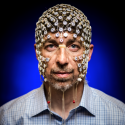Technique moves practical Alzheimer diagnosis one step closer to reality
Researchers at the University of Wisconsin–Madison School of Medicine and Public Health are moving closer to a significant milepost in the battle against Alzheimer’s disease: identifying the first signs of decline in the brain.

Johnson
After years of frustrating failure to stop late-stage Alzheimer’s, it’s essential to find and treat the mild stages, says Sterling Johnson, professor of geriatrics. “We need to identify Alzheimer’s as early as possible, before the really destructive changes take place. Typically, by the time we diagnose Alzheimer’s disease, patients have already lost much of their brain capacity, and it’s difficult or impossible for them to recover.”
The earlier phases, before large numbers of brain cells have been killed, should be more amenable to treatment, Johnson says. Alzheimer’s disease is the largest single cause of dementia. Early symptoms include memory decline, eventually progressing to widespread cognitive and behavioral changes.
In a study published in the journal Cerebral Cortex in December, Johnson, Ozioma Okonkwo in the Department of Geriatrics, and colleagues reported on measurements of brain blood flow in 327 adults. The researchers used an advanced form of MRI to compare blood flow in people with Alzheimer’s, a preliminary stage called mild cognitive impairment, or those who had no symptoms but had a family history of Alzheimer’s.
Reduced blood flow signifies reduced activity in particular parts of the brain, often due to the atrophy of nerve cells. One affected structure, called the hippocampus, is necessary for making new memories. In mild to moderate cases of Alzheimer’s, 40 percent or more of the hippocampus has disappeared.
As expected, the Alzheimer’s patients had lower blood flow in several brain regions linked to memory. People with mild cognitive impairment had a milder version of the same deficits. And people whose mother (but not father) had Alzheimer’s had clear signs of reduced blood flow, even though they lacked symptoms.
Johnson, who is also a neuropsychologist in the Geriatric Research Education and Clinical Center at the William S. Middleton Memorial Veterans Hospital in Madison, is a member of the Alzheimer’s Disease Research Center in the School of Medicine and Public Health.
“I’m getting more optimistic. We understand more with each year, and are very encouraged that we are able to detect Alzheimer’s before the onset of dementia.”
Sterling Johnson
Other techniques that can measure blood flow are more costly and require the use of radiation and injecting a drug tracer during the scan, Johnson says. If this non-invasive MRI technique continues to prove itself, it could be a key to detecting Alzheimer’s disease in its early, and hopefully more treatable, phases.
“In the new paper, we showed that the same areas that show up with more established scanning techniques also are identified with this MRI blood flow technique, in people with Alzheimer’s and mild cognitive impairment,” says Johnson. “So this method is valid and reliable, and is now ready to begin deployment in treatment research with people at risk.”
Earlier diagnosis could expand the use of approved drugs that can treat Alzheimer’s symptoms, Johnson says, but an immediate benefit would be to streamline trials of chemicals that offer new ways to dissolve the amyloid plaque that is toxic to brain cells.
The need to slow or prevent Alzheimer’s grows with the aging population. Despite decades of research, clinical trials have not produced a drug that can definitively halt the advance of Alzheimer’s, Johnson says. “Very few drugs have been approved, and they are just for treating symptoms. But I’m getting more optimistic. We understand more with each year, and are very encouraged that we are able to detect Alzheimer’s before the onset of dementia.”
A trial that focused only on people who are on the path to Alzheimer’s and used brain imaging as a marker of disease progression could achieve results on drug effectiveness with 200 subjects that would otherwise require 1,500 or 2,000 people, Johnson says — accelerating the pace for discovering an effective treatment at a lower cost.
In many people, brains are already changing during their 40s and 50s, says Johnson. “This is the time frame we need to focus on, and our imaging methods make this possible. By the time the symptoms are really obvious, it may be too late. Now we can study before the symptoms begin, and someday intervene while there is still a chance to forestall this devastating disease.”



